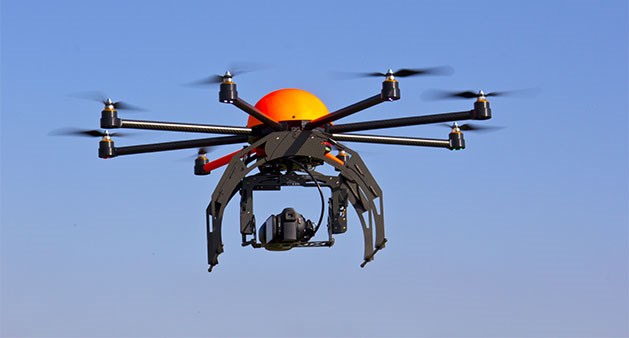Successful innovation starts when someone finds a gap in the market.
Malcolm Connolly, a chemical engineering graduate, found his – dangling off the end of a rope.
For 10 years he had been ‘working at height’, inspecting North Sea oil and gas installations, often hundreds of feet in the air and in challenging and dangerous conditions.
“He thought there must be an easier way to do this,” said Craig Roberts, who is now CEO of the company that Malcolm founded.
There was. Malcolm and his team at Cyberhawk guided the development of a fleet of remote-controlled aerial vehicles that could fly in 28mph winds, operate in high ambient temperatures and inspect flares while live and, it turned out, do a week’s work in an afternoon.
One such job saved an off-shore gas drilling and production platform in South East Asia more than $2 million and eliminated the need for their staff to work at height, dramatically improving safety.
“In the past they would have had to shut down the plant for seven days to allow time for a rope access crew to access and inspect the flare,” said Craig.
Today Cyberhawk, which uses remotely-operated aerial vehicles to inspect everything from live flare tips to chimney stacks, ducting and pipe racks to the underdeck of off-shore oil and gas installations, has an impressive list of clients including Shell, BP, Chevron, Exxonmobil, Total and INEOS and has worked for many of the world’s largest energy companies in Europe, the Middle East and Asia.
While the public debate rages on over the ethics of using drones for bombing missions, Cyberhawk is proud of the pioneering work it is doing to lift people out of danger.
In 2010 when Cyberhawk agreed to inspect an on-shore flare for INEOS Grangemouth, it was venturing into the unknown. No one had attempted to fly an unmanned aerial vehicle within a few metres of a flare tip.
After several on-shore flare inspections, Cyberhawk conducted what it understands to be the world’s first off-shore inspection in the North Sea in 2011 for ConocoPhillips.
And in 2012 it became the first company to inspect an off-shore wind turbine off the UK coast.
“Leading the field, though, has meant we have had to establish our own training and R&D centre,” said Craig. “We believe if you want to grow your company in a dynamic manner, you need to invest in research and development.”
INEOS initially hired Cyberhawk to inspect its live flare stacks and chimneys at its Grangemouth plant in Scotland, UK.
“In the past INEOS would have had to shut down the flare, with the associated loss in production, perhaps erect scaffolding around the flare tip and then send a technician to the top of the stack, ” said Craig. “Now production can now continue as normal while we inspect the flare and there’s no need for people to work at height or in dangerous areas.”
High definition video, photographic and thermal images – captured by the remotely-operated aerial vehicles – allow anomalies to be identified and thermal images help to identify potential problems such as “burn back” where the gases are igniting within the body of the flare.
“We can see what a person would see inspecting a shut-down flare but, because we inspect the flares while they are live, we can also obtain thermal images,” he said. “We also inspect all the flare whereas a person would only note the points of interest.”
Once the job is done, the results are discussed on-site immediately.
Each aerial vehicle is battery-powered, has eight propellers, and may be fitted with a still camera, HD video recorder, gas sensor and a thermal imaging camera. But even with all that kit on board, it still weighs less 2kg.
“To illustrate how light and small our aerial vehicles are, we often compare it to a large seagull – at least when we’re speaking to clients who operate in the North Sea,” said Craig.
Accidents have been known to happen. But to others.
In April this year a UK shop owner became the first person successfully prosecuted by the Civil Aviation Authority for dangerously flying a small unmanned surveillance aircraft within 50 metres of the Jubilee Bridge on the Walney Channel in Cumbria.
“It can be a problem because it is easy to buy a hobby kit and fly in a public area without an understanding of how to safely operate the remotely-operated aerial vehicle,” said Craig. “What Cyberhawk does is a million miles away from that.”
Cyberhawk’s ‘pilots’ are trained to the highest possible standard – and trained to expect the unexpected.
To qualify as an off-shore pilot, Cyberhawk staff must first pass four levels of internal training and certification over-and-above the basic qualification supported by the Civil Aviation Authority. And its services are proving invaluable.
“Because we are able to monitor a problem very easily, companies can, despite having an issue, often avoid unplanned shutdowns and stick with their planned shutdown programme,” said Craig.
Inspecting live flare tips, though, is only part of Cyberhawk’s success story.
It has also used its remotely-piloted aerial vehicles to record the construction progress of a whisky bottling plant, survey a restored opencast mine, inspect meteorological masts at sea and monitor a herd of seals without disturbing their natural environment. INEOS has also used Cyberhawk to film sites for use in short films to help inform its communities.























